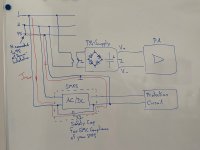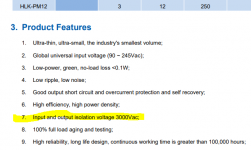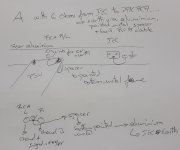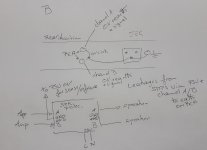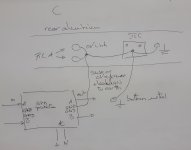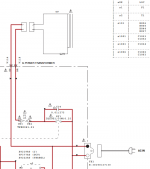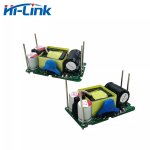Any SMPS is basically a rectifier - smoothing - high voltage chopped AC - induced AC in low voltage side - feedback to control the primary cycle, and DC conversion with smoothing.
So polarity here is only for the NTC or whatever is used as inrush controller or EMI filter.
So it does not really matter on a small SMPS, the kind used for cell phone chargers and routers. And you can mostly plug them in wrong way around without much risk.
Computer supplies used polarized plugs, they can orient the circuit properly.
So polarity here is only for the NTC or whatever is used as inrush controller or EMI filter.
So it does not really matter on a small SMPS, the kind used for cell phone chargers and routers. And you can mostly plug them in wrong way around without much risk.
Computer supplies used polarized plugs, they can orient the circuit properly.
Edelbastler wrote about Y2, I didn't understand that... "This reduces the risk of fire and electrical shock. The capacitors are also individually safety certified, depending on their position in the circuit. Special “X” capacitors have to be used across the input terminals and “Y” capacitors from the AC circuit to ground." I found some more details here: TDK-Lambda FAQ: EMC/EMI Filters
Yes, I assume such a filter including link to ground can be simplified (Hi-Link suggests it also), as this converter is only a low 3W one.
I noticed ESP32/Arduino teams use such same 3W converters, without the inductor. But they keep the MOV, the 0.5A slow fuse, add a 72°C thermal fuse.
I will add some parts, but mainly for safety. I'm almost sure that part doesn't add noise on my signals, I now only get some if I act on connections outside the amp.
Yes, I assume such a filter including link to ground can be simplified (Hi-Link suggests it also), as this converter is only a low 3W one.
I noticed ESP32/Arduino teams use such same 3W converters, without the inductor. But they keep the MOV, the 0.5A slow fuse, add a 72°C thermal fuse.
I will add some parts, but mainly for safety. I'm almost sure that part doesn't add noise on my signals, I now only get some if I act on connections outside the amp.
I added those external 1,5mm² copper wires to optimise current flows bettween 0V's of amp, DAC, DAC PSU and PC. Changed something. On that part, I had noticed AC floating voltages from 100mV (PC) up to 60V (DAC PSU). So this is now all nailed to 0V and earth. Previously, such currents could only flow via the DAC and the RCA cable.
Now I'm wondering why that setup still is so sentitive to any mains noise. As soon as I power something up around in the room, I get pops in loud speakers. I never noticed that with my TV, neither with other audio stuff here.
The DAC PSU (15W, toroïd) has a minimal EMI filter. The PC should have its own. Only the amp has noting on mains line.
I still do not care about that SMPS without EMI filter. That shall generate mainly high freq noise. It works at constant current and voltage output, powering two relays, shall run so at high efficiency. This SMPS may cause only problems at startup, for mains line, as its specs annouce an inrush current of up to "10A<" for that little thing.
Now I added a 10A EMI filter to the amp power line (hoping that will not blow due to inrush currents, transformator seems big).
And I will listen more so... It is still sentitive to my solder iron, when I plug it to mains, my other audio stuff never poped so.
Now I'm wondering why that setup still is so sentitive to any mains noise. As soon as I power something up around in the room, I get pops in loud speakers. I never noticed that with my TV, neither with other audio stuff here.
The DAC PSU (15W, toroïd) has a minimal EMI filter. The PC should have its own. Only the amp has noting on mains line.
I still do not care about that SMPS without EMI filter. That shall generate mainly high freq noise. It works at constant current and voltage output, powering two relays, shall run so at high efficiency. This SMPS may cause only problems at startup, for mains line, as its specs annouce an inrush current of up to "10A<" for that little thing.
Now I added a 10A EMI filter to the amp power line (hoping that will not blow due to inrush currents, transformator seems big).
And I will listen more so... It is still sentitive to my solder iron, when I plug it to mains, my other audio stuff never poped so.
Last edited:
The Y2-capacitor is used to route unwanted RF disturbances from the secondary side of a SMPS to Earth. If the input of your SMPS has a PE connection, then this capacitors connects the secondary ground to PE on the primary side. If the SPMS has no PE input, the Y2 cap only be connected to on of the mains input lines. Thats OK from an RF point of view, because line impedance to Earth is low enough in the RF range. Because this capacitor is crossing the isolation barrier it has to fullfill special safety requirements.
Almost every SMPS will include such a capacitor.
Assuming you have used a small SMPS without an PE input, the Y2 cap now either be effectively connected to L or N of your mains input. It simply depends how you have connected your mains plug to the wall socket. N and PE is connected together at your house installation. So if unfortunately the Y2 cap is connected to L, a capacitive current is flowing from L over the cap to the ground of your amplifier and because (your mentioned that) your ground is connected to PE it can flow to PE. Along the way your signal circuits can pick up this current either galavanic or inductive. Your can simply prove my assumption, when you reverse the mains plug in the wall socket.
The attached picture should help understanding.
Almost every SMPS will include such a capacitor.
Assuming you have used a small SMPS without an PE input, the Y2 cap now either be effectively connected to L or N of your mains input. It simply depends how you have connected your mains plug to the wall socket. N and PE is connected together at your house installation. So if unfortunately the Y2 cap is connected to L, a capacitive current is flowing from L over the cap to the ground of your amplifier and because (your mentioned that) your ground is connected to PE it can flow to PE. Along the way your signal circuits can pick up this current either galavanic or inductive. Your can simply prove my assumption, when you reverse the mains plug in the wall socket.
The attached picture should help understanding.
Attachments
> the Y2 cap now either be effectively connected to L or N of your mains input
Ok, this is now much more clear with your drawing. I do not see a cap for this role around the SMPS. Shall this be inside of it? It is a small 3W SMPS only, without PE connection
> when you reverse the mains plug in the wall socket
Cannot do that due to plugs. Will try later, by rewiring L+N wires of the SMPS, to listen for any difference.
Won't that produce a constant noise as a permanent current will flow from L to PE, via Y2 cap? Maybe Y2 cap is too small for this.
Ok, this is now much more clear with your drawing. I do not see a cap for this role around the SMPS. Shall this be inside of it? It is a small 3W SMPS only, without PE connection
> when you reverse the mains plug in the wall socket
Cannot do that due to plugs. Will try later, by rewiring L+N wires of the SMPS, to listen for any difference.
Won't that produce a constant noise as a permanent current will flow from L to PE, via Y2 cap? Maybe Y2 cap is too small for this.
Now I have crossed L/N on the small SMPS side, like suggested by Edelbastler.
According to, I'll be able to tell how it is wired, I've a L tester (typical screwdriver). And if I find my capmeter, I shall be able to tell if there is any cap present between AC/Vo- or not. I don't think any exists, it should be isolated up to 3000Vac...
I've still the 10A EMI filter on the amp mains input. But I removed my 0V wirings between amp/DAC/PSU/PC. And could changed my RCA cable for a better one.
Listening now so to some problematic tracks. So far, no noise. But I will need several hours to confirm how it behaves that way (noise may not pop in during hours).
According to, I'll be able to tell how it is wired, I've a L tester (typical screwdriver). And if I find my capmeter, I shall be able to tell if there is any cap present between AC/Vo- or not. I don't think any exists, it should be isolated up to 3000Vac...
I've still the 10A EMI filter on the amp mains input. But I removed my 0V wirings between amp/DAC/PSU/PC. And could changed my RCA cable for a better one.
Listening now so to some problematic tracks. So far, no noise. But I will need several hours to confirm how it behaves that way (noise may not pop in during hours).
Attachments
Yes indeed, the current should not be that much. But I would simply try it, to rule it out. I already had a few strange experiences with Y caps. The first one was 25 years ago, when I fumbled on the backside of aVCR in search for IEC antenna connector and noticed, that there was some "electrostimulation" of my right forefinger. If the Y cap is OK, it should not be more than 0.5mA, so I guess you would have to pass a very sensible point of your circuit.
Du you think the hum is more likely 50 or 100Hz?
Du you think the hum is more likely 50 or 100Hz?
Trial is ongoing, like described, music being on hours per day. For the time being, I only found one more track/record with noise inside. I may then also later revert to confirm, or pull out the EMC filter, add one to that SMPS...
Needs time for confirmations, I can have no noise for long periods, hours, and with pop, noise gets barely noticable. If it is cause by any neighbour activity, I won't have a result untill he returns from week-end 🙂
According to, next days, I'll keep or pull this SMPS out. I checked, I have no room for a small 6VA transformer. I would then need to regulate (and keep cool) from the amp supply, what I wanted to avoid.
I may perhaps also try with any DC/DC switching converter, from amp supply voltage, for 12V.
My main concern being also speakers protection, I won't test without. Maybe with Mosfets, so far, I didn't found an available solution, which seems more flexible for its PSU:
https://www.diyaudio.com/forums/solid-state/318946-ssr-speaker-protection-34.html#post6702626
For hum, it may depend? 50 is mains, 100 is rectified or filtered. Don't know what hum freq is with vacuum filaments.
Needs time for confirmations, I can have no noise for long periods, hours, and with pop, noise gets barely noticable. If it is cause by any neighbour activity, I won't have a result untill he returns from week-end 🙂
According to, next days, I'll keep or pull this SMPS out. I checked, I have no room for a small 6VA transformer. I would then need to regulate (and keep cool) from the amp supply, what I wanted to avoid.
I may perhaps also try with any DC/DC switching converter, from amp supply voltage, for 12V.
My main concern being also speakers protection, I won't test without. Maybe with Mosfets, so far, I didn't found an available solution, which seems more flexible for its PSU:
https://www.diyaudio.com/forums/solid-state/318946-ssr-speaker-protection-34.html#post6702626
For hum, it may depend? 50 is mains, 100 is rectified or filtered. Don't know what hum freq is with vacuum filaments.
Last edited:
Something that helped with the setup I have that uses a PC for a source, is to use a ferrite on the USB cable. I have a network cable that had the same issue, but I suspect you don’t have that to worry about.
Also my experience with the line power showed that it’s best to not use a Y capacitor, leave the ground be and focus on the line/neutral. An isolation transformer helps too. Can search “DIY Shunyata” and find some basic circuits that work for AC line filtering for line/neutral arrangements. Always use a rated steel enclosure for such circuits, observing a conforming safety ground, proper air gaps, crimped connections, etc.
Also my experience with the line power showed that it’s best to not use a Y capacitor, leave the ground be and focus on the line/neutral. An isolation transformer helps too. Can search “DIY Shunyata” and find some basic circuits that work for AC line filtering for line/neutral arrangements. Always use a rated steel enclosure for such circuits, observing a conforming safety ground, proper air gaps, crimped connections, etc.
I tested with a USB cable from another PC/DAC/amp setup, which is noise free since 6 years (that DAC has decent full USB isolation, DAC to amp is balanced), got noise with that 20cm cable. The USB cable I'm currently using has ferrites at both ends.
Tried a lot so. Added a EMI/VBUS filter on PC USB port: ordered a cheap one, opened it, seems to be a Audioquest Jitterbug... Have a Wurth USB 2.0 EMI filter, I didn't test so far.
Don't know what I could do more on PC side. I may swap the DAC for the old/early isolated one, but this isn't my objective.
Currently, I'm working with live mains and earth, I'm used to... and know how to deal with that. Amp chassis plus 0V being earthed.
Tried a lot so. Added a EMI/VBUS filter on PC USB port: ordered a cheap one, opened it, seems to be a Audioquest Jitterbug... Have a Wurth USB 2.0 EMI filter, I didn't test so far.
Don't know what I could do more on PC side. I may swap the DAC for the old/early isolated one, but this isn't my objective.
Currently, I'm working with live mains and earth, I'm used to... and know how to deal with that. Amp chassis plus 0V being earthed.
Last edited:
Those are some drawings about wirings, to clarify what I did.
It came with A, ground via chassis frame, screews and paint, spacer. I had found 6 Ohms via my RCA to IEC earth. This made me check and test with the currents flowing from PC and DAC PSU to earth via RCA cable (those currents exist, make crackles if I break or make contacts).
I changed it for B, sure badly assuming this SMPS is perfect, with no leakage to earth. With B wirings, such SMPS currents flow via channels boards 0V traces to earth.
Currently, wiring is B. I thought changing it for C, to avoid SMPS leakages via channel boards.
For better understanding, I will keep B wiring as it could be more sensitive, to further test the L/N swap on the SMPS 220V input. And change this later only.
PS: on the speaker protection board, I have four GND points (same pcb trace). I used only one point, currently linked to PSU 0V, for reference.
It came with A, ground via chassis frame, screews and paint, spacer. I had found 6 Ohms via my RCA to IEC earth. This made me check and test with the currents flowing from PC and DAC PSU to earth via RCA cable (those currents exist, make crackles if I break or make contacts).
I changed it for B, sure badly assuming this SMPS is perfect, with no leakage to earth. With B wirings, such SMPS currents flow via channels boards 0V traces to earth.
Currently, wiring is B. I thought changing it for C, to avoid SMPS leakages via channel boards.
For better understanding, I will keep B wiring as it could be more sensitive, to further test the L/N swap on the SMPS 220V input. And change this later only.
PS: on the speaker protection board, I have four GND points (same pcb trace). I used only one point, currently linked to PSU 0V, for reference.
Attachments
The Y2-capacitor is used to route...
The attached picture should help understanding.
That helped a lot. I was now wondering on which pin the Y2 cap of my PC is located. And what the polarization rules for sockets N/L are in my country. To check and rearrange my wirings where needed. Found that answer:
CEE 7/5 socket and CEE 7/6 plug (French; Type E)... Although the plug is polarised, CEE 7 does not define the placement of the line and neutral and there is no universally observed standard.AC power plugs and sockets - Wikipedia
I was fully in line with our local standards, no one cares here 🙂
My setup is now (again...) quiet since hours, the weird sounds or my neighbours are gone.
- Noticed that on the amp, I added a basic/common single stage EMI filter. On the DAC PSU (linear), the filter is also single stage. PC should have the same elementary filter. This could explain why I still get pops whilst connecting my solder iron (30W). And I noticed more advanced EMI/mains filters can be build (dual stage and others).
- Amp caps are 4 x 10 000uF.
- On the RCA analog side, the cable is better, could have damped the PSUs and other noises in that section (including those radiated by my cell phone or by Wifi...).
- The SMPS wires where and still are reverted...
- I opened the service manual of my other amp, which is quiet since 6 years. Wanted to see how they deal with mains EMI. That is the attached picture: a switch, a fuse. That amp has no SMPS inside, with my wirings described above. On its mains line, I added only a lightning surge protection.
- I think I've just triggered such same low level weird noises testing and moving my cell phone top of DAC and RCA cables. And canot reproduce it. My previous RCA cables where much more sensitive to my phone proximity, got out each time very différent and loud noises patterns. I'll add this to my tests, cell phone top of DAC and those RCA cables...
4G noises (not the well known 2G bips), now I found this: Test des interferences 4G/3G/2G sur mon ampli [PART #1] - YouTube
Catched the trigger or source, and the exact same popping/random/discrete noises patterns, with those new RCA cables. Using my phone top of DAC, and scrolling like in that video, using Twitter. I am very happy so, that will now be manageable 🙂
I do not use my phone that much, it is just lying around, more or less close to the DAC when I have the music on. For calls, I mute the music. So I didn't catch the relation. Phone is now thrown away 🙂
The DAC is a Topping D50s, and the amp boards are Chineese Q405 clones, which I'm using at low levels (the first watts). The association is excellent. I didn't test it, but the cheaper Topping D10s DAC is probably also excellent, the analog parts around ES9038Q2M could be similar.
Attachments
Last edited:
I added again some ground/earth wirings. All noises (RF, pops, clicks) are now gone. Including the pops caused by my fridge motor or my solder iron. All is gone.
Sound is much better so, even for 16bits/44.1 CD quality.
Next days, I'll do some cleanup (mechanical, electical, wirings and connectors), including for safety (no more foam, at least a fuse and a thermal fuse for that SMPS, I'll keep it).
I still don't know if this SMPS has or not a Y2 cap. According to its datasheet and most representations, it has none. As one suggested above in the discussions, It might be like any other low wattage converter you can conect in any way to a socket. But would then produce a small leakage current to earth also.
The only evidence I found is the attached picture. Picture may be off a "pro" or specific version, but I didn't find any such doc.
Sound is much better so, even for 16bits/44.1 CD quality.
Next days, I'll do some cleanup (mechanical, electical, wirings and connectors), including for safety (no more foam, at least a fuse and a thermal fuse for that SMPS, I'll keep it).
I still don't know if this SMPS has or not a Y2 cap. According to its datasheet and most representations, it has none. As one suggested above in the discussions, It might be like any other low wattage converter you can conect in any way to a socket. But would then produce a small leakage current to earth also.
The only evidence I found is the attached picture. Picture may be off a "pro" or specific version, but I didn't find any such doc.
Attachments
Respect, you are doing EMC debugging very patiently 🙂
The blue cap, which ist mounted above the optocoupler is the Y2 cap.
The blue cap, which ist mounted above the optocoupler is the Y2 cap.
- Home
- Amplifiers
- Solid State
- Occasionnal noise in audio: grounding issue?
